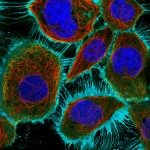Link to Pubmed [PMID] – 28065308
Methods Cell Biol. 2017;137:239-251
Cytokinesis is an essential step of cell proliferation leading to the physical separation of the dividing cells. Cytokinesis relies on both large scale and local scale cell shape changes, and terminates with the final abscission cut that requires close apposition of the plasma membrane. While furrow ingression is a prominent feature of the early phase of cytokinesis and is easy to visualize in all models, from dividing eggs to culture cells, the later steps of cytokinesis until abscission can be much more difficult to visualize. One key issue is to combine live-cell imaging over several hours and detailed, structural analysis of the cell shape changes in 3D, in particular at the time of cytokinetic abscission. Here, we describe the methodologies that we recently developed for studying cytokinetic abscission in human culture cells using live-cell phase-contrast microscopy, combined with correlative scanning electron microscopy. This allows us to determine the membrane surface and underlying cytoskeleton of the intercellular bridge with unprecedented precision and to determine the fate of the midbody remnant after abscission.

